Brindle Blanket
According to Mae West, “Too much of a good thing can be wonderful,” and when it comes to our Big Good Wool, we have to agree. Knit up into our gorgeous, squishy, warm, and toasty Brindle Blanket, it shows just how wonderful big and good can be!
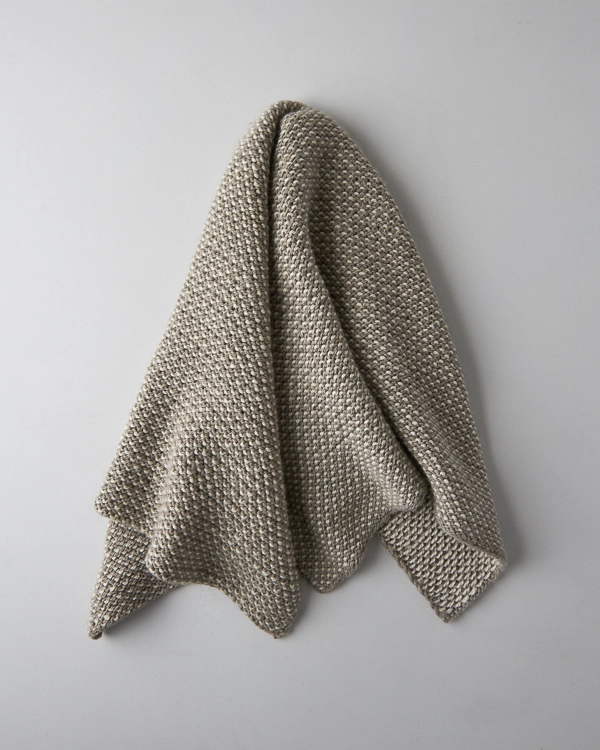
A simple slip stitch pattern brings together two natural Big Good Wool colors, just as the sheep grew them. Pretty stippling on one side and streaky stripes on the other, like the coat of a beautiful brindle greyhound, it may look (and sound!) complicated, but each row uses just one color at a time… No sweat!
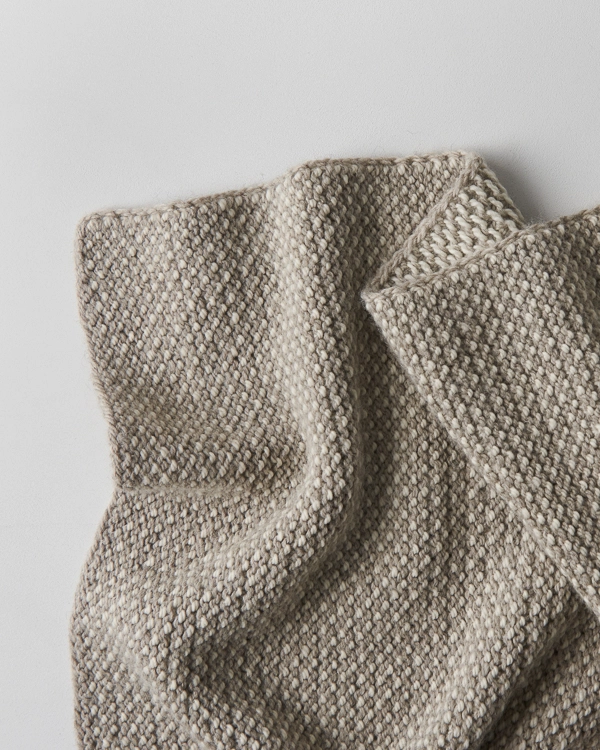
And because Big Good Wool knits up at about 3½ stitches to the inch, you’ll make quick work of this cozy project. You cast on only 151 stitches and need just 7 skeins for the throw size (or a mere 121 stitches and 5 skeins for baby!).
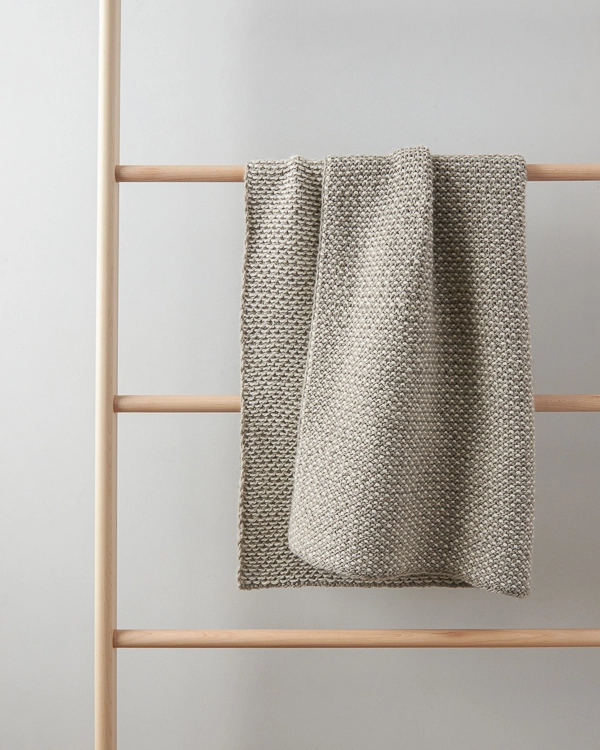
A subtle beauty, the Brindle Blanket may differ with Mae West there, but even she would maybe have agreed that a warm and toasty, weighty and snuggly Brindle Blanket is pretty wonderful!
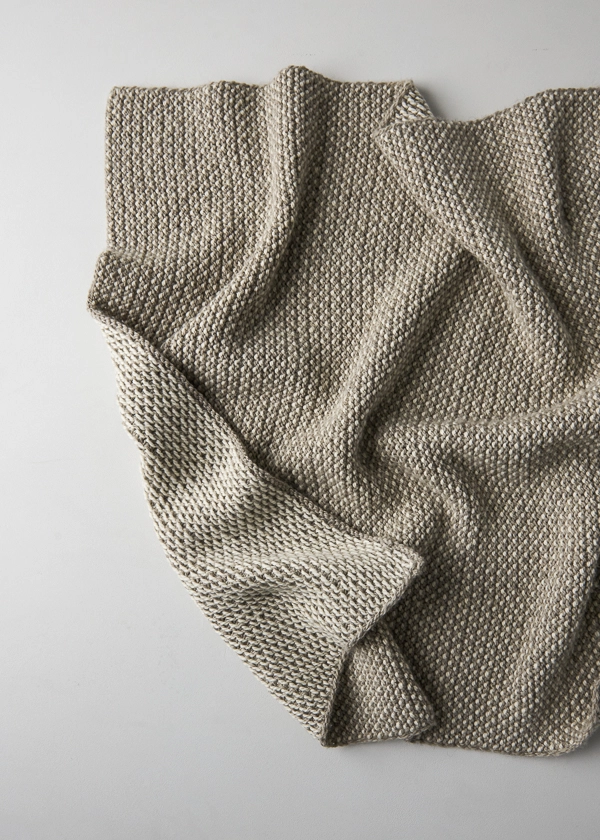
Designed by Purl Soho designer, Jake Canton. Click here to see even more of Jake’s designs!
Share your progress + connect with the community by tagging your pics with #PurlSoho, #PurlSohoBusyHands, and #PurlSohoBrindleBlanket. We can’t wait to see what you make!
Materials
- Color A: 3 (4) skeins of Purl Soho’s Big Good Wool, 100% undyed Andean highland wool. Each skein is 274 yards; approximately 778 (1096) yards required. We used Driftwood Gray. (Please Note: Big Good Wool is no longer available. To view our full line of Purl Soho yarns, click here! Be sure to check your gauge when substituting yarns.)
- Color B: 2 (3) skeins of Big Good Wool. Approximately 436 (675) yards required. We used Heirloom White.
- US 10 (6 mm), 32- or 40- inch circular needles
Gauge
15 stitches and 36 rows = 4 inches in stitch pattern
Size
Crib (Throw)
Finished Dimensions: 32 inches wide x 42 inches long (40 inches wide x 52 inches long)
Notes
Slip Stitches
Slip all slip stitches purlwise unless indicated otherwise in the pattern.
Turn + Slide
When you work this pattern, you either “slide” or “turn” the work at the end of each row.
“Turn work” means to do what you would normally do when knitting rows with circular needles: Transfer the needle from your left hand into your right hand and the needle from your right hand into your left, flipping the work around so the opposite side is facing you.
“Slide work” means to keep the same side of the work facing you and to push all the stitches to the right end of the circular needles. Without turning the work, start the new row as you normally would.
You will know that you’re doing this right if the yarn you need to complete the next row is right there waiting for you!
Pattern
With Color A, cast on 121 (151) stitches.
Row 1 (wrong side): With Color A, slip 1 (see Notes) with yarn in front (wyif), knit to end of row, turn work (see Notes).
Row 2 (right side): With Color B, slip 1 knitwise wyif, *k1, slip 1 with yarn in back (wyib), repeat from * to last 2 stitches, k1, slip 1 wyif, slide work (see Notes).
Row 3 (right side): With Color A, slip 1 wyif, purl to last stitch, k1, turn work.
Row 4 (wrong side): With Color B, slip 1 wyib, *slip 1 wyif, p1, repeat from * to last 2 stitches, slip 1 wyif, slip 1 wyib, slide work.
Repeat Rows 1-4 until piece measures 42 (52) inches.
Cut Color B.
Repeat Row 1.
Bind Off (right side): With Color A, loosely bind off knitwise.
Weave in the ends and block, if desired.
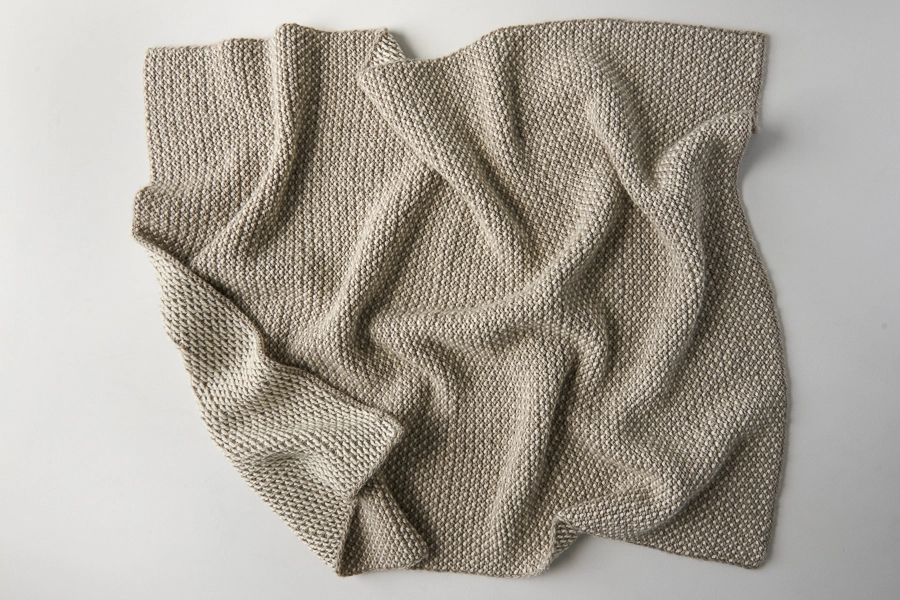
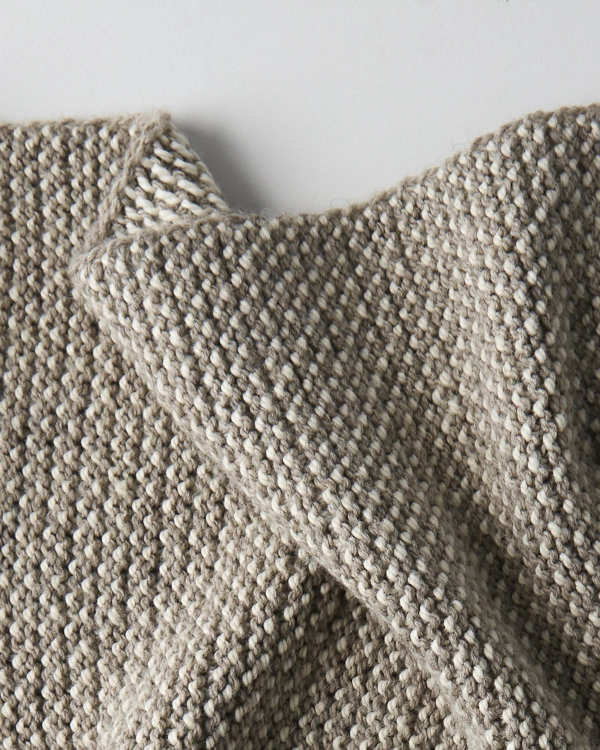


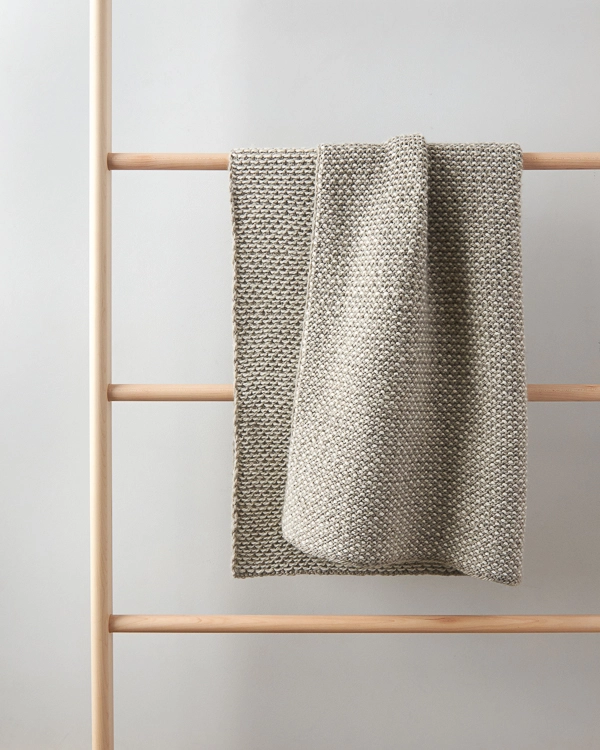
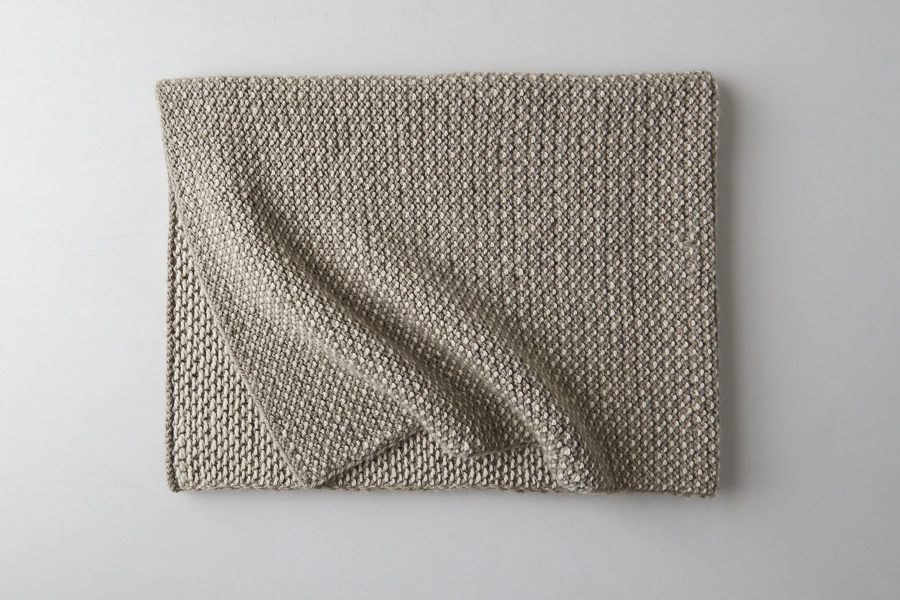
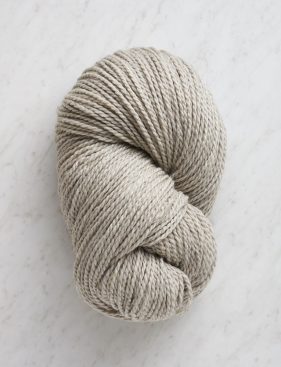
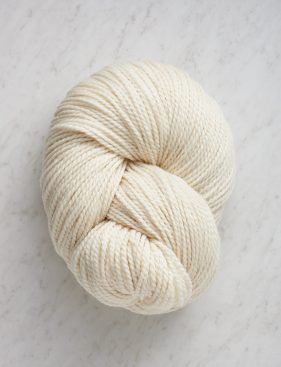


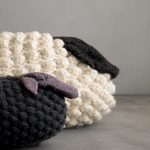

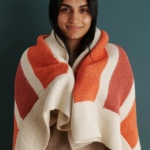
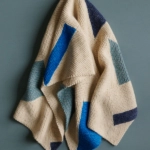


Why is so much more yardage required of Color A than Color B? I want to make sure I have enough yarn before starting, and when reading the pattern it’s not jumping out at me why there would be such a difference. Could be I need more coffee. 🙂 Thank you.
Hi Cathy,
Great question! When you are working this stitch pattern, you will be knitting or purling entire rows with Color A, and alternating knits or purls with slipped stitches whenever you are knitting with Color B. The slipped stitches use up very little yarn, so you don’t need as much of Color B.
I hope that clears things up!
Julianna
Is this yarn machine washable or hand washable?
Hi Norma,
Great question! Our washing instructions for Big Good Wool are to hand wash gently in cold water and lay flat to dry.
Best,
Julianna
Does this pattern come for an adult throw or only crib blanket.
Thank you
Lisa
Hi Lisa,
Thanks for reaching out! The pattern above includes both a crib and throw size. Whenever you see two numbers in the instructions, the first number will be for the crib size and the second for the throw – for instance, the cast on instructions read, “With Color A, cast on 121 (151) stitches.” This means that, for the crib size, you will cast on 121 stitches, or for the throw size, you will cast on 151 stitches.
I hope that helps, and happy knitting!
Julianna
What a beautiful pattern! I would like to get a sense of the itchiness and scratchiness of the Big Good yarn. How would this yarn compare to Brooklyn Tweed’s Shelter? I realize everyone has a different tolerance level but comparing it to a yarn I’ve worked with would be helpful. Thanks!
Hi Marly,
Thanks so much for the kind words and for writing in! I am a huge fan of both Shelter and Big Good Wool, and I would say that Big Good Wool feels a bit softer than Shelter. It is spun differently, so the overall texture is much smoother, even though the wool fiber we use is fairly similar, which makes it friendlier to sensitive skin,. With wear, it will soften up even more!
I hope that helps!
Julianna
is there another alternative yarn for this beautiful blanket ? Something with more color options but that would still work – weight, etc. Thanks,
Hi Jeanne,
Great question! I think Brooklyn Tweed Quarry would be a wonderful yarn to use in this blanket! It should knit up to the same gauge as Big Good Wool, but I would still recommend knitting a gauge swatch. You will need 4 (6) skeins of Color A and 3 (4) skeins of Color B.
I hope that helps, and please do let us know how it turns out!
Julianna
Looks extra cozy!!!
Would this pattern and yarn be too heavy for a 12 in x 70 in scarf?
Hi Linda,
Thanks for writing in! Actually, this pattern would be just lovely adapted into a scarf – you can get an idea of how it will turn out from our super bulky weight Brindle Scarf! For a 12 inch wide scarf out of Big Good Wool, you will need to cast on 45 stitches, and it will take 2 skeins of your main color and one of your contrast color.
I hope that helps, and please do let us know how it turns out!
Julianna
Hi Julianna,
Thank you for your quick reply. One more question: Will Color B take less than 1/2 the skein? My thought is to buy enough Color A (i.e. 4 skeins) to knit two scarfs and use the one skein of Color B for both scarfs.
Linda
Hi Linda,
Unfortunately you will need almost the whole skein of Color B – about 270 yards to be exact – so you will one skein per scarf.
Best,
Julianna
Could you make this in any two colors of the Big Wool? Thanks!
Hi Helen,
Great question! Yes, you could use any two colors, but the effect will be more subtle if you choose a color combination that has less contrast. We used Heirloom White and Driftwood Gray which have a medium amount of contrast and still show the pattern quite well, but if you were to choose Heirloom White and Winter Grass, for example, the colors would blend together a bit more. The overall effect would still be quite lovely!
I hope that helps, and happy knitting!
Julianna
I love the look of the crib blanket but am worried about the weight and thickness of the blanket for a baby. Do you have any instructions for working the pattern in lighter weight wool- like worsted? Thanks!
Hello Susan,
Thanks for reaching out! To knit this blanket up with a smaller gauge the first thing you will need to determine is your gauge, or how many stitches you are getting per inch in stitch pattern. Once you know this number you will be able to multiply the number of stitches you are getting per inch by your desired width, this will give you a cast on number. This stitch can be worked over any odd number. With all this in mind you really can knit this blanket up with any weight of yarn.
I hope this helps and let us know if you have any further questions!
-Marilla
Hi, somewhat new to knitting but excited about this beautiful pattern. To incorporate the color B, can I use the seamless join technique? I’m not clear how to start color B from the pattern instructions. And I’m assuming we don’t join the yarn even though we’re knitting in the round, so can I follow instructions for knitting a flat piece on round needles?
Hi Robyn,
Thanks for writing in! I’m not familiar with the seamless join technique, but for this blanket, you will be knitting flat and not in the round, and will still be leaving Color A attached so there’s no need to do anything special to join Color B. On Row 2, after slipping the first stitch, you will simply start knitting with Color B on the second stitch, leaving a six to seven inch tail to weave in later!
Happy knitting!
Julianna
Hi Julianna,
I’m also very new to knitting and would love to knit this blanket for a friend’s baby. I’m really unclear about how to start knitting with the second color on the second row. Are there any videos you could point me to on how to get started on this? Thank you!
Hi SV,
Thanks for the question! Color A will be attached having just completed Row 1, and on Row 2, after slipping the first stitch, you will simply start knitting with Color B on the second stitch, leaving a six to seven inch tail to weave in later! We have a great link for joining a new ball of yarn if you need a visual. I’m sure your friend will love the blanket for her baby!
Happy Knitting
Jessica
Is there any way a video can be made for this pattern. I’m very new to knitting but this blanket looks like a dream for our newest addition’s crib!
Hi Stephany,
Thanks for writing in, and congratulations! Unfortunately we don’t have the resources at the moment to do a video tutorial of this pattern, but I will certainly pass your request along to the design team! This pattern is quite straightforward, even for a beginner, so I hope you give it a try. We are always here to help if you have any questions!
Best,
Julianna
I just happen to have a stash of Worsted Twist in Honey Pink and just ordered some more Heirloom White. How many skeins do you think I’d need of each to make the crib size, please? I have four of Honey Pink and soon to have almost four of Heirloom White. I get around about 5 stitches to the inch in garter stitch with Worsted Twist on a 7 needle. Think I’ll CO 157. The nice thing about baby blankets is the size mostly doesn’t matter!
Hi Catherine,
Thanks for writing in, and what a lovely idea! This blanket should be absolutely beautiful in Worsted Twist. It’s a bit tricky to estimate yardage when altering the gauge like this, but I would recommend having about 7 skeins of your main color and 5 of your contrast color.
I hope that helps, and please do let us know how it turns out!
Julianna
Are there other choices of wool to make this that have more colors. The driftwood is sold out
Hi Amy,
Thanks for reaching out! Brooklyn Tweed Quarry is an excellent yarn to substitute for this blanket, and it comes in quite a few lovely colors you could put together for this blanket!
Best,
Julianna
I am confused about not turning and knitting backwards. On row 3 you purl for the entire row and your needle goes behind the stitch ? How do you knit the last stitch, in front?
Hi Amy,
Thanks for reaching out! There’s no need to knit backwards or reverse your stitches – you will still be purling as you normally would! For this step, you will need to have your blanket on a circular needle, and instead of turning to the wrong side, you will keep the right side facing and slide all your stitches to the other end of the circular needle, where Color A should already be attached and waiting for you. You will then purl this row just like usual!
I hope that clears things up!
Julianna
This is such a gorgeous pattern! I would love to make it for an upcoming baby gift, but hesitate to use wool. Could you possibly recommend an alternative yarn? Would this work well in cotton? I am a fairly new knitter, so any additional info (needle size) would be greatly appreciated!
Thank you!
Hi Wendy,
Great question! Although you would have to alter the pattern slightly for gauge, I think this blanket would be amazing in Blue Sky Worsted Cotton! Since it is a little lighter weight, I would recommend knitting a gauge swatch in pattern on a US 8 needle. You can then multiply your stitches per inch by 32 inches and round to the nearest odd number to determine how many stitches to cast on. It’s a bit tricky to estimate how much yarn you need when modifying the gauge like this, but I think 5 skeins of Color A and 3 skeins of Color B should be enough!
I hope that helps, and happy knitting!
Julianna
Hi there,
I’m having a bit of trouble with the slip-stitch edge: sometimes my Color B will wrap around the outside of one of the rows, around my slip stitch. Any ideas about what might be going wrong?
Hi Filippa,
Thank you for writing in! After knitting a small swatch, I think this issue may be happening in Row 2. At the beginning of Row 2, Color B will be coming out of the front of your knitting a row below, and you are asked to use Color B to slip 1 knitwise wyif, then k1. The first stitch is fine and you can easily slip 1 knitwise wyif because Color B is already coming out of the front. However, when you are preparing your yarn to knit the next stitch it sounds like you are wrapping the Color B yarn around the side of your knitting rather than up and directly between your needles towards the back. Let me know if this makes sense and if it helps at all!
Best,
Gaby
Hi Gaby,
Thanks for getting back to me! I’m sorry, I should have been more specific; it seems as though it’s happening in the fourth row.
Hi Filippa,
I appreciate you writing back! This seems like a similar case, where you may be wrapping your yarn around the side of the blanket to bring it to the front, as opposed to over and between your needles. It’s a little tricky keeping track of whether your yarn should be in the front or the back for this project, but I think that will make all the difference. Let us know how it goes!
Best,
Gaby
Hi! I’d like to make this as a puppy blanket for a new addition to my household – do you have any suggestions for wool or other textile that would hold up better to more frequent washing and rough handling?
Thanks!
McKenzie
Hi McKenzie,
Thanks for writing in! What a lucky pup! I would recommend using Blue Sky Worsted Cotton held double to create a sturdy, washable version of this blanket. Although the official manufacturer’s instructions are to hand wash and lay flat to dry, we have had great success machine washing and drying our blankets out of Worsted Cotton! It might turn out slightly thicker than Big Good Wool when held double, so I would recommend knitting a gauge swatch on US 11 needles. You can then measure your stitches per inch, multiply by the desired width of your blanket, and round to the nearest odd number to determine how many stitches to cast on. You will need 11 (15) skeins of Color A, and 6 (9) skeins of Color B.
I hope that helps, and please do let us know how it turns out!
Julianna
I would like to knit the Brindle Blanket in 10 ply.
How much yarn would I need and what size needles would I need to knit a blanket that is about 40×52 inches. How many stitches would I need to cast on.
Hope you can help, this is going to be my project during lockdown for coronavirus.
Thank you Eleanor
Hi Eleanor,
Thanks for writing in! To modify this pattern for a lighter weight yarn, I would recommend knitting a gauge swatch in pattern using the needle size recommended on your yarn label. You can then multiply your stitches per inch by either 32 inches for the crib size or 40 inches for the throw and round to the nearest odd number to determine how many stitches to cast on.
I hope that helps, and happy knitting!
Julianna
Hi – This looks wonderful! Can you clarify though how the second color – color B – comes into play on row 2? Do you just start using that instead of color A? Just want to be sure I have this correct!
Love this site! thank you!
Hi Lisa,
Thank you so much for the kind words and for writing in! Yes, that’s all there is to it! On the first knit stitch of Row 2, you will simply start knitting with Color B by looping it around your needle, leaving Color A attached and hanging at the beginning of the row. You will come back to it soon!
Happy knitting!
Julianna
Hi there,
Unfortunately, my knitting had a bit of an accident: the entire first stitched unraveled to the bottom of the row, essentially unraveling one of my edges. What would be the best way to fix this mishap?
Hi Filippa,
Thanks for writing in! Oh no! I am sorry to hear that, dropped stitches are the worst! If it is multiple stitches that have been dropped and are unraveled down to the edge, ripping out and starting again may be the easiest solutions. You could also drop down and pick up each stitch and re-knit them back up!
I hope this helps, best of luck!
Gianna
Hi! If I wanted to make a slightly larger version of this blanket (bigger than the throw size included in the instructions), could you provide a recommendation for how many stitches to cast? Or how to determine how many stitches to cast based on how big I want the blanket? Thank you!
Hi Mack,
Thanks for reaching out! As long as your gauge is the same as the pattern you can adjust the cast on that way! The gauge of this pattern is 15 stitches and 36 rows = 4 inches in stitch pattern (or approximately 3.75 stitches per inch) and works over an odd number of stitches, so for example if you want a 60″ blanket you would cast on 225 stitches (3.75 X 60.)
I hope this helps, happy knitting!
All the best,
Gianna
Hi! I just started the Brindle blanket and have a question about row 2. Do I only slip 1 knitwise on the very first stitch, then purlwise the slip stitches for the rest of the row?
So happy I found your website. This will be the perfect throw for my daughter!
Hi Joanne,
Thanks for reaching out! Yes that is correct, you will slip all slip stitches purlwise unless indicated otherwise in the pattern. So for row 2 you will begin by slipping 1 knitwise wyif, then you will slip all the rest of the slip stitches in that row purlwise either with the yarn in back or yarn in front (as indicated)
I hope this helps and please let me know if you have any more questions!
Warmly,
Gianna
Hello. Am I right that the only colors available in Big Good Wool are the Heirloom White and Hickory Nut?
Hi Anne,
Thanks for reaching out! Unfortunately, Big Good Wool is being discontinued so as the colors have sold out they have been removed from the site. Heirloom White and Hickory Nut are the only two colors that we still have stock available in at the moment and once they sell out we won’t be getting any more.
Warmly,
Gianna
Gianna,
Thanks. Do you think those two colors would work for this pattern?
—Anne
Hi Anne,
Thanks for writing in again! Yes I think those two colors would work beautifully! I actually prefer Heirloom White and Hickory Nut over the original combination since it will have a bit more contrast!
Warmly,
Gianna
Since you don’t sell Big Good Wool, can you recommend a comparable yarn that you do have? Also it would be helpful to know what weight Big Good Wool was — chunky, worsted or sport?
Thanks!
Margaret
Hi Margaret,
Thanks for writing in! Big Good Wool is a bit tricky to categorize since the weight was unique and kind of between categories, however, we categorized it as a bulky/chunky weight! The closest yarn to substitute for this blanket would be Brooklyn Tweed Quarry! I would also recommend working a gauge swatch prior to beginning to ensure you are consistent with the pattern!
I hope this helps, happy knitting!
Gianna
Hi, I am practicing the stitch to make the Brindle throw. Everything is good except fo the edges. I am practicing by making a wash cloth out of two colors of cotton yarn. Anyway, my edges do not look as neat and tight as the edges on throw in the picture. Any advice please.
Hi Donna,
Thanks for reaching out! Since this pattern calls for slipping the first stitch of every row, that will be the key to a tidy edge! When you first slip the stitch, as well as when you later knit the slipped stitch, be extra careful not to overstretch it! That can cause loopy edges that can look a bit messy. Once you finish knitting, Blocking your finished washcloths/finished blanket can also help re-distribute stitches and give you an overall cleaner look!
I hope this helps and please let me know if you have any other questions!
Hello I like many seem to have the same question on adding color B to second row. Do I just loop the second color over needle and slip first stitch over it? All videos I look at never show first stitch as adding a new color.
Hi Shirley,
Thanks for reaching out! You will slip the first stitch just as you would normally and then join in the new color when you knit the second stitch!
I hope this helps!
Gianna
I’m going to make this as a baby blanket for friends who live in Arizona, so I’m going with the Big Sky Worsted Cotton you recommended. Color A will be Azul. Can you recommend a good color for the contrast? I find it so difficult online. Thank you.
Hi Julie,
Thanks for reaching out. If you’re going for a darker overall look, then I’d recommend pairing Azul with Jasper. But if you’re going for a lighter look, then I’d recommend Bone! I hope this helps you to plan your project.
All the best,
Lili
Would this blanket work with purl soho’s super soft merino. I understand the gauge is different and I am ok with the throw being larger. Thx in advance
Hi Diane,
Yes, you can absolutely use Super Soft Merino for this pattern! You would be able to knit it to the indicated dimensions by adjusting how many stitches you cast on. To figure out your cast-on number, you will want to first knit a gauge swatch in pattern. Once you know how many stitches you are getting per inch, you can multiply that number by the width that you would like and cast on the nearest odd number of stitches. Then you can follow the pattern as written!
All the best,
Lili
How many stitches should I cast on to make a washcloth using this stitch?
Thank you!
Hi Jeanette,
Thanks for reaching out! The number of stitches you cast on will depend on what yarn you are using, your needle size, and how many stitches per inch you are getting! We have a tutorial about gauge here that you might find helpful for your project! Once you calculate how many stitches per inch you are getting with your chosen yarn and needles, you can multiply that by the desired width of the washcloth!
Please let us know if you have any questions!
All the best,
Carly
love love love this pattern. thank you for it.
how many stitches should I cast on to get it larger than 40″ (151 stitches) but less than 60″ ( 225 stitches)
Hi Susan!
Thank you for your comment! For a 45″ wide blanket, you can cast on 169 stitches. For a 50″ wide blanket, you can cast on 189 stitches, and for a 55″ wide blanket, you could cast on 207 stitches. If you would like to figure out a size not mentioned, you can multiply your desired width by 15, and then divide that number by 4 and round up to the next odd number to find your cast-on amount!
I hope this helps, and happy knitting!
All the best,
Margaret
Is there a hat pattern where I can use this wool? I have some skeins leftover.
Hi Amy,
Thanks for writing in! While we unfortunately never designed any hat patterns with Big Good Wool, I think that it would work very well for the Nesting Hat. You should be able to match the gauge of this pattern, and the stitch pattern will show off the beautiful rustic spin of the yarn!
All the best,
Lili
Hi,
I love this blanket and purchased the wool and the needles. Since I am a beginner, I find it a rather challenging task. I’ve started over 6 times. I’ve research this on YouTube however have not found the Brindle blanket anywhere.
Help
Alice
Hi Alice,
I’m so sorry to hear that you’ve started your blanket over so many times, and we’re eager to help! I would recommend signing up for a 1-On-1 Project Help appointment where a team member will be happy to chat or demonstrate the stitch pattern in real time.
All the best,
Lili
Hello! I stumbled upon this website by accident and absolutely LOVE it. I’ve spend HOURS exploring it and am excited to begin the Brindle Blanket in the throw size.
The pattern calls for Big Good Wool; however it has been discontinued so I will make it in Good Wool instead using the same colorway as specified in the pattern. This yarn is DREAMY!
My questions are these:
1) I would like to make the throw larger (60”). How many stitches do I cast on to get this width using the substitute yarn?
2) To make the larger throw (60”), how much yarn will I need for color A and color B?
Thanking you in advance!
Hi Lenora,
Thanks for writing in, and I’m so glad to hear that you love this pattern! To figure out your cast-on number, you will want to first knit a gauge swatch in pattern (if this is daunting, we have a wonderful tutorial called All About Gauge). Once you know how many stitches you are getting per inch, you can multiply that number by the width that you would like and cast on the nearest odd number. Then you can follow the pattern as written!
And were you hoping to make this blanket 60 by 60 inches (a square)? Or did you have another measurement in mind for the length? Let me know, and then I can give you an estimate of how much yarn you’d need!
All the best,
Lili
I just finished row 4 and put down my knitting before sliding and before starting row 1 again. So now I’ve lost where I am, and what side I’m on. Is the wrong side the striped side, and the dotted side the right side? Thanks!!
Hi Mary,
That’s correct! The little dots made from the stitch pattern are on the right side and the stripes are on the back. To be safe I would add a lifeline before continuing on to row 1 just to be sure. This way, in the case you have to rip back, you won’t need to undo all of your hard work! I hope this helps but please let me know if you have any questions!
Happy knitting,
Gavriella
That absolutely helps!!
I have another question….
Somehow I keep ending up with an extra stitch. I’m not sure when, or how I’m doing it. I feel like I get the pattern now. I’m totally getting into the groove. I thought I was following it meticulously….. Although, clearly I’m not. If I have no clue, likely you don’t either. When I see the pattern is off I count and then knit two together. Do you have any insight into how this may be happening?! Have others had this problem?
That is very interesting! I am not entirely sure how you might be ending up with an extra stitch as there are no increases or decreases. If you don’t mind, could you send a photo of your work to customerservice@purlsoho.com so we could have a deeper look?
Love this pattern! I used a different yarn and thought I had adjusted the number of stitches for my gauge, but it has turned out a little narrower than I wanted. It’s not quite finished yet, but is 36″ wide. I’d like to add some width to it by using my contrast color to add a knit border to each of the long selvedge edges. Would that look strange? I’m having trouble visualizing it.
Thanks! I’ve been knitting Purl Soho patterns for years and I love them all! They’re so beautiful and modern.
Hi Meghan,
Thank you for writing in! I think a knitted border would look great on your project and could provide a really nice finished look to your blanket! You could use our Picking Up Stitches Tutorial to see how this could be done as well. I hope this helps!
Happy knitting,
Gavriella
Thank you! I held my yarn doubled. Would you suggest holding it double for a knitted border or held as a single strand?
You are very welcome! I would recommend holding the yarn double to match the main fabric of your blanket.